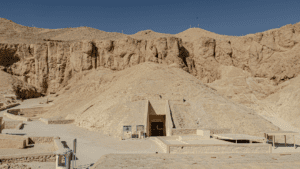

Home » Weekly Blog » Unraveling Mysteries: The Ancient Wonders of Egypt
Egypt, the land of the pharaohs, stands as a testament to the enduring marvels of human civilization. With a history that spans millennia, this ancient land has captivated the imagination of scholars, explorers, and dreamers alike. From the monumental pyramids of Giza to the enigmatic Sphinx, the Valley of the Kings’ royal tombs to the grand temples of Luxor and Karnak, Egypt is a treasure trove of archaeological wonders that continue to unravel the mysteries of our past.
A. Rich History and Cultural Significance
To embark on a journey through the ancient wonders of Egypt is to step back in time and witness the birthplace of one of the world’s earliest and most advanced civilizations. Egypt’s history can be traced back to the predynastic period, around 3100 BCE, when Upper and Lower Egypt were unified under the rule of King Menes. This marked the beginning of the dynastic era, which saw the rise and fall of powerful pharaohs, the construction of awe-inspiring monuments, and the flourishing of art, science, and literature.
The Nile River, often referred to as the lifeblood of Egypt, played a pivotal role in shaping the country’s destiny. Its annual floods enriched the soil, allowing for bountiful harvests and fostering a stable and prosperous society. The ancient Egyptians, with their advanced understanding of agriculture and irrigation, thrived along the fertile banks of the Nile.
Beyond its agricultural significance, the Nile also served as a highway for trade and transportation, connecting various regions of Egypt and facilitating cultural exchange. This unique geographical feature not only contributed to the unity of the Egyptian state but also influenced the religious and symbolic aspects of their civilization.
B. Teaser about the Ancient Wonders and Mysteries
As we embark on this exploration of the ancient wonders of Egypt, we are poised to unravel the secrets of a civilization that left an indelible mark on the world. The iconic pyramids of Giza, standing tall against the backdrop of the desert, beckon us to contemplate the engineering prowess of a bygone era. The enigmatic Sphinx, with its stoic gaze, guards the secrets of the pharaohs buried in the nearby tombs of the Valley of the Kings.
The temples of Luxor and Karnak, adorned with intricate carvings and towering columns, transport us to a time when gods and goddesses were revered, and ceremonies unfolded in grandeur. The Great Library of Alexandria, a symbol of knowledge and enlightenment, sparks our curiosity about the lost wisdom that once graced its shelves.
Yet, amid these wonders, there are mysteries waiting to be unraveled—hieroglyphics etched into ancient walls, the Rosetta Stone holding the key to a forgotten language, and unexplained phenomena that defy easy explanation. Join us on this journey as we delve into the heart of ancient Egypt, where each stone tells a story, and each artifact holds a piece of the puzzle that is waiting to be solved.

A. Historical Background on the Construction of the Pyramids
The Pyramids of Giza, one of the Seven Wonders of the Ancient World, stand as enduring symbols of ancient Egyptian ingenuity and monumental architecture. Built during the Fourth Dynasty of the Old Kingdom, these pyramids were colossal tombs for pharaohs, constructed to ensure a smooth transition to the afterlife. The three main pyramids—Khufu (Cheops), Khafre (Chephren), and Menkaure—loom large on the Giza Plateau, a testament to the organizational and engineering skills of the ancient Egyptians.
The construction of these pyramids is shrouded in mystery, with theories ranging from advanced ancient technologies to the organization of a massive workforce. Theories suggest that the stones used in the pyramids, some weighing several tons, were quarried locally and transported using sledges and wooden rollers. The precision with which these stones were cut and the alignment of the pyramids with astronomical precision have fueled speculation about the advanced knowledge and planning involved.
B. Architectural Marvels and Engineering Feats
The sheer scale and precision of the pyramids continue to astound archaeologists and engineers today. The Great Pyramid of Khufu, the largest of the three, consists of approximately 2.3 million limestone and granite blocks. The construction methods, including the arrangement of these massive stones and the alignment of the pyramids with cardinal points, suggest a deep understanding of geometry and astronomy.
The construction of the pyramids also raises questions about the workforce responsible for their creation. While traditional views point to a massive labor force of slaves, some researchers propose that a skilled and well-organized workforce, rather than sheer numbers, was the key to completing such colossal projects. The logistics of feeding, housing, and managing a large workforce in the inhospitable desert terrain add another layer to the mystery.
C. Theories and Mysteries Surrounding the Purpose of the Pyramids
Despite centuries of study, the exact purpose of the pyramids remains a subject of debate. The prevailing theory is that these structures served as elaborate tombs for pharaohs, housing not only their mortal remains but also treasures and artifacts to accompany them into the afterlife. However, alternative theories suggest that the pyramids held a more profound cosmic or religious significance, acting as a conduit between the earthly realm and the divine.
The alignment of the pyramids with celestial bodies, particularly the Orion constellation, has led some to speculate about an astronomical purpose beyond mere burial chambers. Additionally, the mathematical precision encoded in the dimensions of the pyramids has sparked theories about hidden mathematical and mystical knowledge possessed by the ancient Egyptians.
As we peer into the depths of these ancient structures, we find not only grand tombs but also a tapestry of symbolism and mystery that continues to capture the imagination of historians, archaeologists, and enthusiasts alike. The Pyramids of Giza, standing as silent sentinels of a bygone era, invite us to unravel the layers of history and delve into the enigma that is ancient Egypt.

A. Introduction to the Sphinx and its Significance
Standing at the forefront of the Giza Plateau, the Sphinx emerges as an iconic symbol of ancient Egypt. Carved from the natural limestone bedrock, this colossal statue combines the body of a lion with the head of a pharaoh, traditionally believed to represent Pharaoh Khafre. The Sphinx’s enigmatic presence adds an extra layer of mystique to the Giza complex, seemingly guarding the nearby pyramids and holding secrets that stretch back through the corridors of time.
The Sphinx’s role in ancient Egyptian culture extends beyond mere aesthetics. Often associated with the sun god Ra and the concept of royal power, the Sphinx served as a guardian figure, both in the earthly realm and the afterlife. Its imposing presence was meant to ward off evil spirits and protect the pharaoh’s eternal resting place.
B. Legends and Myths Associated with the Sphinx
Over the centuries, the Sphinx has woven itself into the fabric of myth and legend. One of the most enduring tales is the Sphinx’s riddle, a challenge posed to travelers attempting to pass by. According to Greek mythology, the Sphinx asked, “What walks on four legs in the morning, two in the afternoon, and three at night?” The answer, of course, is humanity: crawling as an infant, walking upright in adulthood, and using a cane in old age. Oedipus is said to have solved this riddle, allowing him safe passage.
The Egyptian belief in the Sphinx’s protective qualities is reflected in various inscriptions and carvings near the statue. The Sphinx, with its gaze fixed toward the rising sun, symbolized the eternal cycle of life, death, and rebirth. Such mythical associations reinforce the Sphinx’s role as a powerful and symbolic guardian within the broader context of ancient Egyptian beliefs.
C. Ongoing Research and Discoveries Related to the Sphinx
Despite its age, the Sphinx continues to be a subject of intense scholarly inquiry. Archaeologists and geologists have conducted studies to understand the origins of the statue, its original appearance, and the geological factors that have influenced its erosion over the millennia.
Recent research, including non-invasive techniques such as ground-penetrating radar, has sought to unveil potential hidden chambers or tunnels beneath the Sphinx. These explorations aim to shed light on the purpose and function of the Sphinx beyond its surface symbolism. The ongoing efforts to decipher the inscriptions and hieroglyphics found near the Sphinx contribute to our understanding of its cultural and religious significance.
As we stand in the shadow of the Sphinx, its weathered features and timeless gaze beckon us to contemplate not only the mysteries of the past but also the ever-evolving nature of archaeological discovery. The Sphinx, with its dual role as a guardian and a riddle, invites us to partake in the ongoing journey of unraveling the secrets held within the embrace of ancient Egypt.

A. Exploration of the Burial Ground for Pharaohs and Nobles
Nestled on the west bank of the Nile near Luxor, the Valley of the Kings stands as a testament to the intricate beliefs of the ancient Egyptians concerning the afterlife. Unlike the pyramids of Giza, which served as grand tombs visible on the horizon, the Valley of the Kings was a hidden necropolis, carefully chosen to protect the resting places of pharaohs and nobles from tomb robbers.
The valley served as the primary burial ground for pharaohs of the New Kingdom, spanning the 16th to the 11th centuries BCE. The rugged cliffs of the valley provided a natural barrier, concealing the elaborate tombs and treasures hidden within. The elaborate and richly decorated tombs within the valley reflect the importance ancient Egyptians placed on the journey to the afterlife and the preservation of the pharaoh’s spirit.
B. Famous Tombs and Their Treasures
Among the many tombs that dot the Valley of the Kings, some have achieved particular renown for their opulence and the treasures they contain. The tomb of Tutankhamun, discovered by Howard Carter in 1922, stands out as one of the most significant archaeological finds of the 20th century. The young pharaoh’s burial chamber contained a wealth of artifacts, including the iconic golden mask that covered his mummy.
Other notable tombs include those of Ramses II, Seti I, and Tuthmosis III, each revealing unique insights into the religious beliefs and funerary practices of their respective eras. Elaborate wall paintings and hieroglyphics within these tombs depict scenes from the deceased’s life, religious rituals, and guidance for the journey to the afterlife.
C. Unraveling the Mysteries of the Elaborate Burial Rituals
The Valley of the Kings provides a profound glimpse into the complex belief system of the ancient Egyptians regarding the afterlife. The elaborate burial rituals, intricate tombs, and carefully curated treasures all served a specific purpose in ensuring the well-being of the deceased in the hereafter.
The Book of the Dead, a collection of spells and prayers, was often included in the tombs to guide the soul through the perilous journey of the afterlife. The careful placement of funerary goods and the construction of intricate burial chambers were believed to assist the deceased in overcoming challenges and reaching a state of eternal bliss.
While the Valley of the Kings has been extensively studied, ongoing research continues to reveal new facets of ancient Egyptian burial practices. Advanced imaging technologies, such as 3D scanning and virtual reconstructions, offer fresh perspectives on the layout and contents of these tombs, deepening our understanding of the religious and cultural significance attached to the journey beyond mortal life.
As we explore the Valley of the Kings, we step into the shadows of the past, where the secrets of the afterlife were eternally guarded by the silent guardians of the tombs. The mysteries concealed within this sacred valley continue to captivate archaeologists and historians, inviting us to unlock the spiritual and cultural significance woven into the fabric of ancient Egyptian civilization.

A. Historical Context and Significance of the Luxor and Karnak Temples
As the sun sets along the banks of the Nile, the Temples of Luxor and Karnak stand as majestic witnesses to the grandeur of ancient Egypt. These temples, located in the city of Thebes (modern-day Luxor), were dedicated to different gods and served as centers for religious and political activities during the New Kingdom period.
The Luxor Temple, dedicated to the god Amun-Ra, was largely built by Amenhotep III and later expanded upon by Ramses II. It was linked to the Karnak Temple by an ancient processional avenue known as the Avenue of Sphinxes, creating a symbolic connection between the two religious complexes.
The Karnak Temple, on the other hand, is a vast complex dedicated to the Theban Triad—Amun, Mut, and Khonsu. It is the largest religious complex ever built, spanning over 200 acres. Construction of the Karnak Temple spanned centuries, involving numerous pharaohs who each left their mark on its architecture, making it a living record of ancient Egyptian religious beliefs and practices.
B. Architectural Features and Religious Aspects
The Temples of Luxor and Karnak are architectural marvels, showcasing the artistic and engineering prowess of the ancient Egyptians. The Luxor Temple, with its grand entrance, colossal statues, and intricate carvings, served as a focal point for religious ceremonies and festivals. The Karnak Temple, with its massive pylons, hypostyle halls, and obelisks, conveyed the power and grandiosity of the pharaohs and the gods they served.
The religious significance of these temples is evident in the detailed reliefs and inscriptions that adorn their walls. Scenes depicting pharaohs making offerings to the gods, religious rituals, and divine processions provide insights into the ancient Egyptian worldview and their deep connection to the divine.
C. Preservation Efforts and Ongoing Research at these Ancient Sites
While the Temples of Luxor and Karnak have withstood the test of time, preservation efforts are crucial to protect these invaluable relics from the erosive forces of nature and human impact. UNESCO, in collaboration with Egyptian authorities, has been actively involved in conservation projects to safeguard the temples for future generations.
Ongoing research at these sites continues to unveil new discoveries. Advanced archaeological techniques, including ground-penetrating radar and 3D scanning, have revealed hidden chambers, structures, and details about the construction methods employed by ancient builders. Such revelations contribute to a deeper understanding of the temples’ original layouts and the evolution of religious practices over time.
As we wander through the colossal columns and sacred precincts of Luxor and Karnak, we are transported back to an era where gods and pharaohs walked the same hallowed grounds. The Temples of Luxor and Karnak, with their timeless allure, beckon us to explore the intersection of the divine and the mortal in the heart of ancient Egypt.

A. Overview of the Legendary Library’s History and Cultural Impact
Nestled on the shores of the Mediterranean, the Great Library of Alexandria stands as an emblem of intellectual prowess and cultural richness in the ancient world. Founded in the 3rd century BCE, during the reign of Ptolemy II Philadelphus, this monumental library became a beacon for scholars, philosophers, and scientists from across the known world. Its purpose extended beyond a mere repository of scrolls; it aimed to collect the entirety of human knowledge, fostering an environment where scholars could engage in intellectual pursuits and share their findings.
The Great Library’s cultural impact was profound, shaping the intellectual landscape of the Hellenistic world. The scholars who graced its halls contributed to advancements in various fields, including mathematics, astronomy, medicine, and philosophy. The library became a symbol of Alexandria’s cosmopolitan nature, drawing thinkers from diverse cultural backgrounds and fostering a spirit of intellectual exchange.
B. Theories Surrounding its Destruction and the Loss of Knowledge
Despite its illustrious history, the fate of the Great Library remains one of history’s great mysteries. The prevailing theory suggests that the library met its untimely demise through a series of unfortunate events, including fires, conflicts, and political upheavals. The most commonly cited incident is the burning of the library during the Siege of Alexandria in 48 BCE, a tragic episode during the conflict between Julius Caesar and Cleopatra.
However, historical records are scant and conflicting, leading to speculation and debate among historians. Some argue that the destruction was gradual, spanning centuries and involving multiple incidents. Others contend that remnants of the library persisted even after these events, only to be lost over time due to neglect and lack of patronage.
The loss of the Great Library is often lamented as one of the greatest tragedies in the history of knowledge. The destruction of countless scrolls, treatises, and manuscripts has left an intellectual void, with the full extent of the lost works remaining a tantalizing enigma. The burning of the Great Library has become a symbol of the fragility of human knowledge and the potential consequences of the destruction of cultural heritage.
C. Modern Efforts to Revive the Spirit of the Library of Alexandria
In the modern era, there have been symbolic efforts to revive the spirit of the Great Library of Alexandria. The Bibliotheca Alexandrina, inaugurated in 2002, stands on the same ground as its ancient predecessor, aiming to be a center of learning, research, and cultural exchange. The new library, with its striking architecture and advanced facilities, seeks to recapture the essence of the original library by fostering collaboration among scholars, hosting cultural events, and providing access to a vast collection of books and digital resources.
While the Bibliotheca Alexandrina cannot fully replace the lost treasures of its ancient predecessor, it stands as a testament to the enduring human quest for knowledge and the resilience of cultural institutions in the face of historical challenges.
As we reflect on the rise and fall of the Great Library of Alexandria, we are reminded of the fragility of knowledge and the importance of preserving our cultural heritage. The echoes of the ancient library resonate through the ages, urging us to continue the pursuit of knowledge and to safeguard the repositories of wisdom that enrich our understanding of the world.
A. Importance of Hieroglyphics in Ancient Egypt
At the heart of ancient Egyptian communication and record-keeping was the intricate system of hieroglyphics. These intricate characters, combining pictorial and symbolic elements, were used for monumental inscriptions, religious texts, and administrative documents. Hieroglyphics played a crucial role in conveying the rich tapestry of ancient Egyptian culture, capturing both the practical and the sacred aspects of daily life.
The use of hieroglyphics extended beyond mere writing; it was a visual language that reflected the interconnectedness of the physical and spiritual realms in the Egyptian worldview. From the grandeur of monumental inscriptions on temple walls to the intimate details of personal tombs, hieroglyphics were a dynamic and expressive means of communication.
B. Discovery and Significance of the Rosetta Stone
The decipherment of hieroglyphics remained an elusive challenge for centuries, leaving a vast portion of ancient Egyptian knowledge inaccessible to modern scholars. This changed dramatically with the discovery of the Rosetta Stone in 1799 during Napoleon Bonaparte’s campaign in Egypt.
The Rosetta Stone, a slab of black basalt inscribed with a decree issued at Memphis in 196 BCE, proved to be a linguistic key to unlock the mysteries of hieroglyphics. The decree was written in three scripts: Greek, Demotic (a later form of Egyptian script), and hieroglyphics. By comparing the known Greek text with the unknown hieroglyphics, scholars such as Jean-François Champollion were able to decipher the ancient script.
C. Decoding Hieroglyphics and the Insights Gained from the Rosetta Stone
Champollion’s breakthrough in the early 19th century marked a pivotal moment in Egyptology. The decipherment of hieroglyphics opened a gateway to the lost world of ancient Egypt, allowing scholars to read religious texts, understand monumental inscriptions, and gain insights into the daily lives of the Egyptians.
The Rosetta Stone not only provided the key to understanding hieroglyphics but also offered a glimpse into the syncretic nature of ancient Egyptian culture. The same text in three scripts highlighted the linguistic diversity of the time and the coexistence of Greek and Egyptian traditions in Ptolemaic Egypt.
As we study the hieroglyphics on the walls of temples and tombs, we are reminded of the profound impact of the Rosetta Stone on our understanding of ancient Egypt. The ability to decode this complex script has allowed us to access the thoughts, beliefs, and stories of a civilization that once thrived along the banks of the Nile. The Rosetta Stone stands as a testament to the power of human ingenuity in unraveling the mysteries of the past and bridging the temporal gap between ancient and modern civilizations.
A. Mysterious Occurrences and Phenomena in Ancient Egypt
Amid the grandeur of ancient Egypt’s architectural marvels and the deciphered hieroglyphics lies a tapestry of mysteries and unexplained phenomena that continue to intrigue researchers. Throughout the years, various accounts and enigmatic occurrences have added layers of mystique to the already captivating narrative of ancient Egypt.
Reports of unusual happenings, from spectral sightings near the pyramids to tales of cursed tombs in the Valley of the Kings, have fueled speculation about the supernatural in ancient Egypt. The line between myth and reality becomes blurred as stories of guardian spirits, divine interventions, and otherworldly forces intertwine with the historical record.
B. Unsolved Mysteries that Continue to Baffle Researchers
Even with advancements in archaeology and technology, some mysteries of ancient Egypt remain elusive. The purpose of certain structures, the identity of specific pharaohs, and the intricacies of certain religious practices continue to perplex researchers.
For instance, the construction methods employed in building the pyramids, despite various theories, have not been definitively settled. The precision with which massive stones were cut and placed in the pyramids raises questions about the tools and techniques available to ancient Egyptian builders.
The fate of Nefertiti, the queen and wife of Akhenaten, remains a tantalizing mystery. Despite extensive archaeological efforts, her tomb has yet to be conclusively identified, leaving scholars to speculate about her final resting place and the role she played in the tumultuous period of Akhenaten’s reign.
Additionally, the purpose of certain ancient Egyptian artifacts, such as the mysterious “Dendera lightbulb” relief, continues to be a subject of debate. While some propose practical explanations, others entertain the possibility of advanced technologies or symbolic meanings that elude our current understanding.
C. Speculations and Theories about these Enigmatic Aspects
The allure of ancient Egyptian mysteries has given rise to various speculations and theories. Some suggest extraterrestrial influences, pointing to perceived anomalies in ancient Egyptian art and architecture as potential evidence of advanced external intervention. Others propose that lost technologies or knowledge once existed but have since vanished from the historical record.
The enigmatic nature of these unsolved mysteries invites a spirit of curiosity and exploration, prompting researchers to delve deeper into the archaeological record and consider alternative perspectives. The quest to unravel these puzzles not only sheds light on the ancient past but also underscores the limitations of our current understanding.
As we navigate the corridors of history, the unsolved mysteries of ancient Egypt beckon us to continue the pursuit of knowledge, encouraging open-minded exploration and the continuous reevaluation of our understanding of this remarkable civilization. The enigmas of ancient Egypt, like fragments of a puzzle waiting to be assembled, remind us that the past is a dynamic landscape, inviting us to uncover its hidden secrets and mysteries.
A. Recap of the Ancient Wonders Explored in the Blog Post
Our journey through the ancient wonders of Egypt has been a captivating exploration of a civilization that has left an indelible mark on human history. From the towering Pyramids of Giza to the enigmatic Sphinx, the sacred Valley of the Kings to the grand temples of Luxor and Karnak, each site we visited revealed layers of mystery, symbolism, and profound cultural significance.
The Great Library of Alexandria, with its intellectual splendor, and the decipherment of hieroglyphics through the Rosetta Stone, bridged the gap between the tangible remnants of the past and the intangible realms of knowledge and communication. As we delved into the depths of the ancient Egyptian civilization, the unsolved mysteries and unexplained phenomena added an extra layer of intrigue, inviting us to ponder the enigmatic aspects that continue to elude our understanding.
B. Emphasis on the Enduring Allure and Ongoing Research in Egyptology
The allure of ancient Egypt lies not only in the monumental structures and artifacts that have survived the ravages of time but also in the rich tapestry of culture, religion, and human ingenuity that these remnants represent. Egyptology, the study of ancient Egypt, remains a dynamic field where new discoveries and interpretations constantly reshape our understanding of the past.
Ongoing excavations, technological advancements in archaeological methods, and interdisciplinary approaches continue to unveil hidden facets of ancient Egyptian civilization. The collaboration between scholars, scientists, and researchers from around the world ensures that the story of Egypt’s past is an ever-evolving narrative.
C. Invitation for Readers to Delve Deeper into the Mysteries of Ancient Egypt
As we conclude our exploration, we extend an invitation to our readers to embark on their own journey into the mysteries of ancient Egypt. Whether through further reading, virtual tours, or planned visits to these archaeological wonders, the fascination of this ancient civilization beckons.
The pyramids, temples, and tombs are not just remnants of a bygone era but windows into the minds and hearts of a people whose legacy endures. The mysteries that persist challenge us to embrace curiosity, critical thinking, and a sense of wonder as we seek to unlock the secrets of this extraordinary civilization.
In the words of Howard Carter, the famed archaeologist who discovered the tomb of Tutankhamun, “The wonderful things that have happened to me have not happened because of any special intelligence on my part, but because I have been enabled by fate and circumstances to have had experiences that, even now, when I think of them, never fail to astonish me.”
May the wonders of ancient Egypt continue to astonish and inspire, inviting us to partake in the timeless adventure of uncovering the mysteries that lie beneath the sands of time.
Sign up to hear about our upcoming adventures, monthly newsletter, exclusive offers, and more!
Required*
Not Ready to book?
Get regular updates on upcoming tour and special promotions.







Sign up for our Mailing List to get updates on our current offerings.